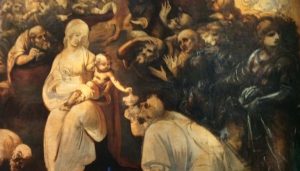Da Vinci’s ‘Adoration of the Magi’ Returns to the Uffizi
 After a six-year absence, Da Vinci’s Adoration of the Magi has come home to the Uffizi in a special exhibition entitled The Magical Cosmos of Leonardo (through Sept. 24), which reveals both the artist’s creative genius and the altarpiece’s lengthy restoration.
After a six-year absence, Da Vinci’s Adoration of the Magi has come home to the Uffizi in a special exhibition entitled The Magical Cosmos of Leonardo (through Sept. 24), which reveals both the artist’s creative genius and the altarpiece’s lengthy restoration.
The unfinished masterpiece has long been considered an enigma, obscured until now by successive layers of dark and discolored varnish that made it virtually unreadable. The painting, Leonardo’s largest, was originally commissioned in 1481 for the main altar of the small church of San Donato, outside Florence’s Porta Romana gate. Da Vinci began work on the composition but just a few months later was called to Milan.
As is common, the altarpiece had been restored many times over the centuries. But in the case of this unfinished piece the numerous added varnish layers, some of which contained pigment, animal glue, and egg white, added to the confusion. Worse still, movements in the layers and in the wood support were causing the paint to separate from the panel.
Beginning in 2011, art historians, conservators and scientists at the Opificio delle Pietre Dure laboratories in Florence studied the Adoration of the Magi for a year just to decide whether to attempt a full restoration. A large screen video in the show details part of the extensive diagnostic testing on this exceptional ‘patient,’ as well as an overview of the painstaking removal of the layers of grime and varnish.
What has been revealed is not just a painting, but Leonardo’s artistic soul and creative process. The viewer can now see how he used the wood panel like a sketchpad, trying out different versions of the figures, a few of whom have been given a preliminary layer of color.
The upper part of the Adoration has a light blue sky, punctuated by dark leafy trees. The details of the imaginative landscape populated by horses, soldiers, dogs and a tiny elephant, are now finally visible.
One of the most interesting finds was made by the art investigation unit of the Carabinieri police, who discovered fingerprints apparently made by a left hand smoothing the fresh paint layer. Although no one is completely certain, the best guess is that Da Vinci himself left the prints.
In an adjoining room, visitors can see another Adoration of the Magi, this one by Filippino Lippi, the artist commissioned to paint his version for the Augustinian fathers of San Donato, who by the 1490s were tired of waiting for Leonardo’s return from Milan. A comparison of the two highlights their similarities and differences. In September 2017, Da Vinci’s Adoration of the Magi will return to the newly renovated Leonardo room on the second floor of the Uffizi. (elizabeth wicks)
